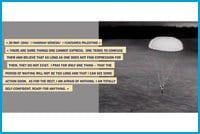When I was in Grade 6at a private Jewish elementary school in Montreal my class read a biography called Hannah Senesh. It was our introduction to a legend of Holocaust history and a national hero of Israel. Recruited in Palestine, Senesh was a paratrooper for the British Army during World War II who was stationed with resistance groups helping Jews escape deportation to concentration camps. She was caught in Hungary, tortured, tried and executed. The book we read when I was 12 ends with Senesh’s diary entries upon first landing in Palestine (she emigrated from Hungary as a young girl), arriving in what she thought of as her Biblical homeland. My teacher wept.
Mention Senesh to any downtown gallery-goer and you’ll probably be met with a blank stare. But those who live in the largely Jewish area around the Koffler Gallery, where lesbian artist Nina Levitt’s brilliant interactive installation Thin Air is, will most likely have a reaction on the same wavelength as my teacher.
Thin Air deals with two women who worked on either side of the military intelligence stakes: Senesh, the field operative, and Vera Atkins, the then-highest ranking female member of British Intelligence (and a closet Jew) who oversaw British spies in occupied France, later helping prosecute Nazi war criminals.
The two women each occupy their own space in the two-room gallery. Atkins is represented by an aluminum hangar and five suitcases, Senesh by a continuously inflating and deflating parachute, a video projection and reproductions of British Intelligence memos. On the Atkins side a video of official military goings-on is projected inside the hangar and onto its door. If you open a suitcase, the projection changes and if you pick one up, a built-in speaker plays excerpts from a 1995 interview where Atkins revisits her wartime experiences: the relief at seeing spies come home safely from their missions, the grief at losing agents, the horror of seeing the camp survivors.
In Levitt’s construction Atkins represents the impenetrable security of the Home Office, while Senesh’s position was far more precarious. Where Atkins is sturdy aluminum, Senesh is a draped parachute which inflates as you enter her installation. The video projection animates excerpted diary entries where Senesh records the anticipation of being called into duty (in and of itself this is a bizarre document, a mix of girlish glee — Senesh was 23 when she died — and steely stoicism). This is all we have of Senesh herself. We have Atkins’ own recollections, 50 years after the fact, but we know Senesh’s fate. Across the back wall of the gallery we have what has to pass as a eulogy for her: a series of telegrams between various offices of British Intelligence trying to sort out the 1,000 pounds-sterling bereavement payment to her surviving mother and brother in Palestine (Levitt gorgeously, subtly lays the telegrams out from right to left — the direction in which one reads Hebrew).
In the end the focus of the installation is documentary so, while there are certainly grander issues informing the work, there’s no metaphoric hook. But there doesn’t need to be: Levitt’s accomplishment is staggering enough, presenting these women’s experiences honestly and artfully, avoiding both heavy-handed didacticism and metaphorical obscurity. As a document it suffices; as a tribute it is more than fitting; as a work of art it excels.

 Why you can trust Xtra
Why you can trust Xtra


